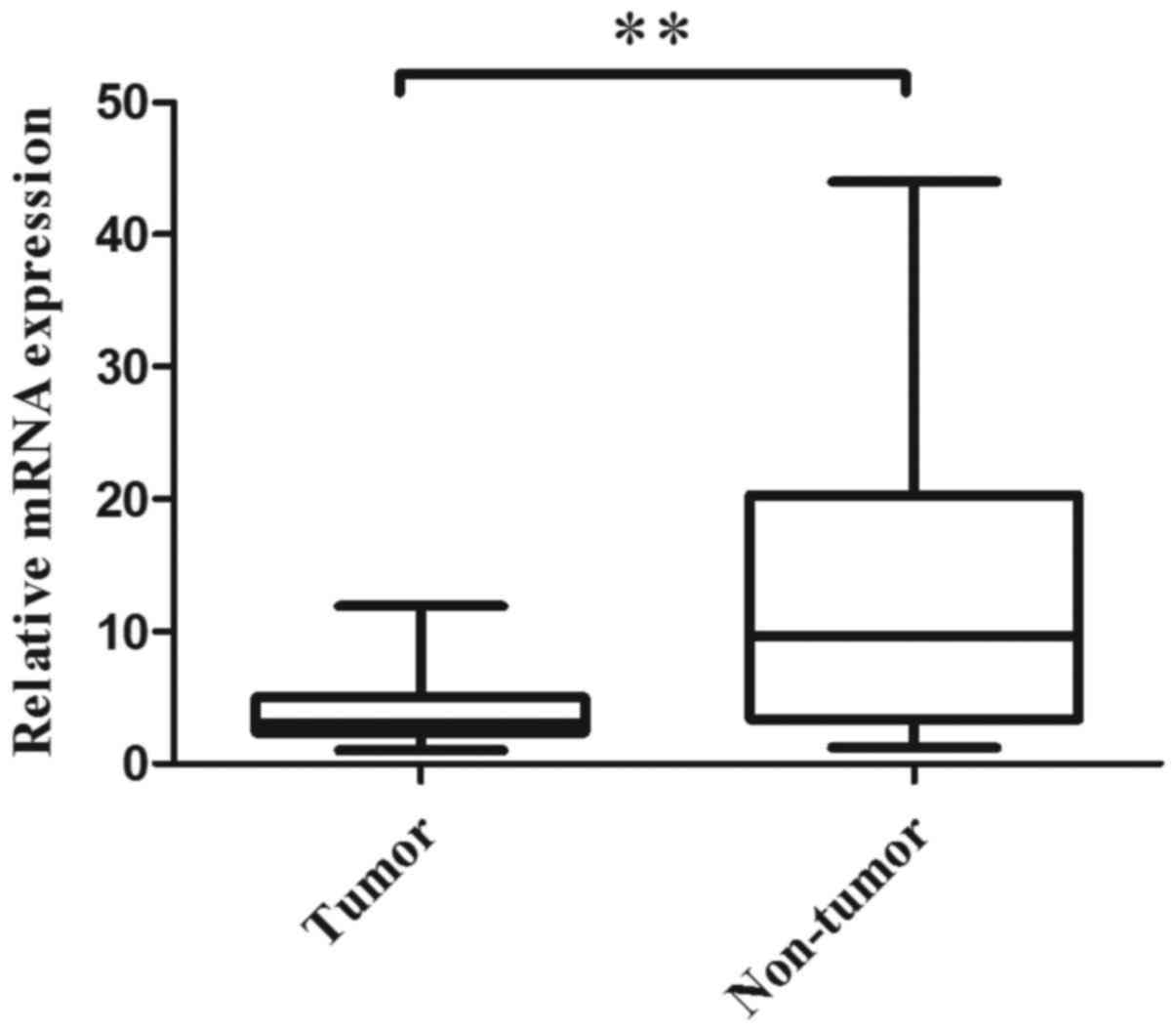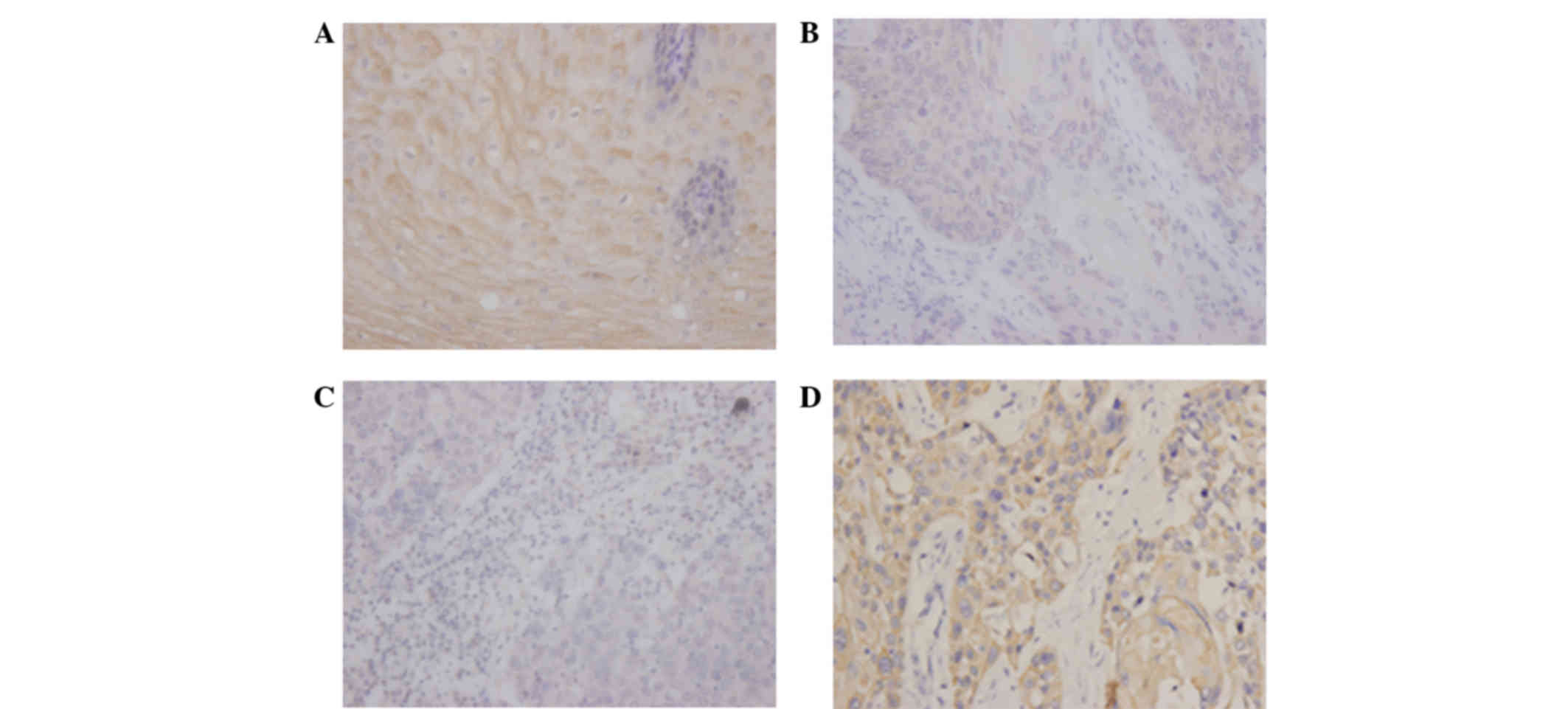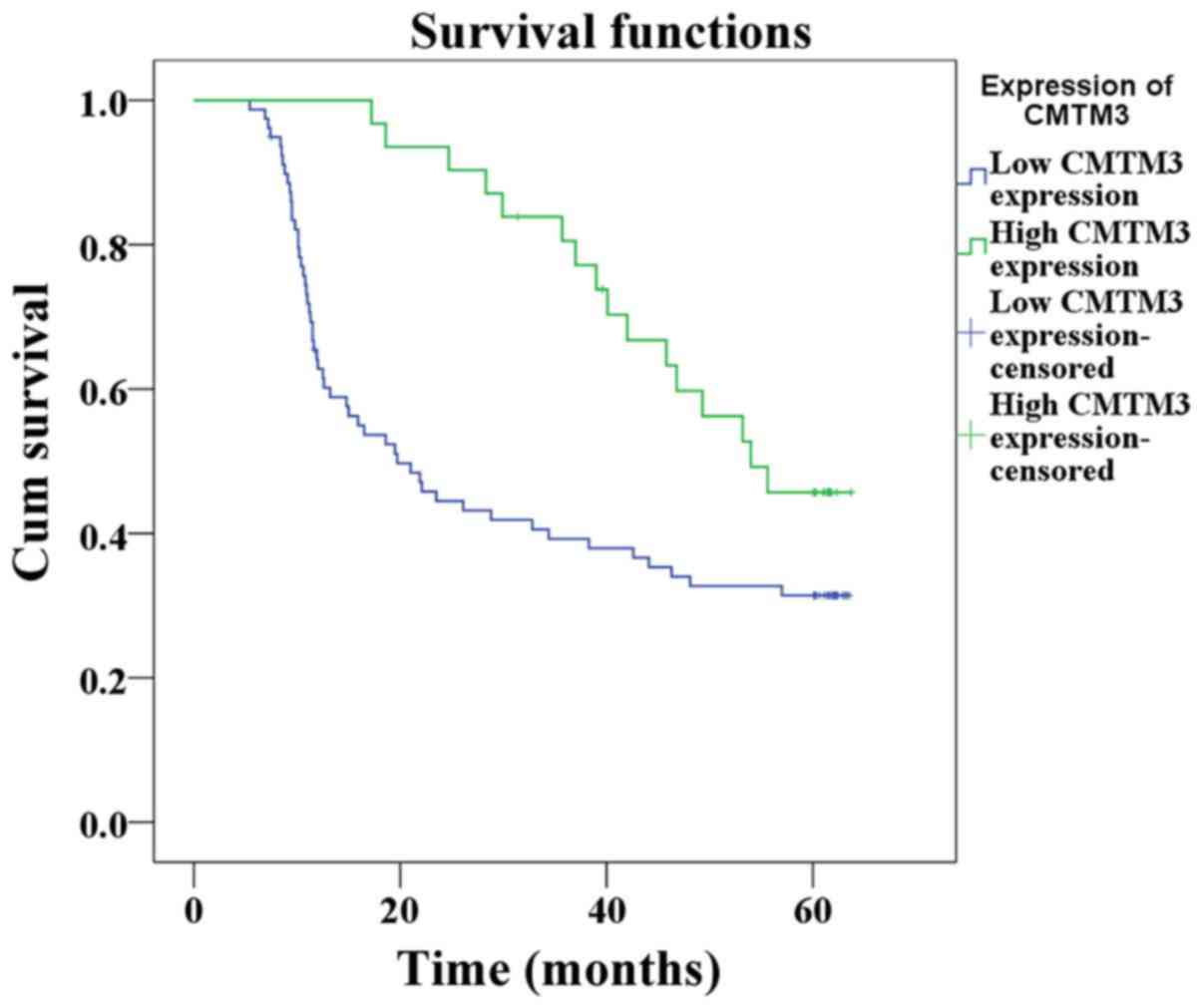|
1
|
Jemal A, Bray F, Center MM, Ferlay J, Ward
E and Forman D: Global cancer statistics. CA Cancer J Clin.
61:69–90. 2011. View Article : Google Scholar : PubMed/NCBI
|
|
2
|
Hongo M, Nagasaki Y and Shoji T:
Epidemiology of esophageal cancer: Orient to Occident. Effects of
chronology, geography and ethnicity. J Gastroenterol Hepatol.
24:729–735. 2009. View Article : Google Scholar : PubMed/NCBI
|
|
3
|
Sun ZG, Wang Z, Liu XY and Liu FY: Mucin 1
and vascular endothelial growth factor C expression correlates with
lymph node metastatic recurrence in patients with N0 esophageal
cancer after Ivor-Lewis esophagectomy. World J Surg. 35:70–77.
2011. View Article : Google Scholar : PubMed/NCBI
|
|
4
|
Thallinger CM, Kiesewetter B, Raderer M
and Hejna M: Pre- and postoperative treatment modalities for
esophageal squamous cell carcinoma. Anticancer Res. 32:4609–4627.
2012.PubMed/NCBI
|
|
5
|
Kranzfelder M, Büchler P and Friess H:
Surgery within multimodal therapy concepts for esophageal squamous
cell carcinoma (ESCC): The MRI approach and review of the
literature. Adv Med Sci. 54:158–169. 2009. View Article : Google Scholar : PubMed/NCBI
|
|
6
|
Han W, Lou Y, Tang J, Zhang Y, Chen Y, Li
Y, Gu W, Huang J, Gui L, Tang Y, et al: Molecular cloning and
characterization of chemokine-like factor 1 (CKLF1), a novel human
cytokine with unique structure and potential chemotactic activity.
Biochem J. 357:127–135. 2001. View Article : Google Scholar : PubMed/NCBI
|
|
7
|
Han W, Ding P, Xu M, Wang L, Rui M, Shi S,
Liu Y, Zheng Y, Chen Y, Yang T and Ma D: Identification of eight
genes encoding chemokine-like factor superfamily members 1–8
(CKLFSF1-8) by in silico cloning and experimental validation.
Genomics. 81:609–617. 2003. View Article : Google Scholar : PubMed/NCBI
|
|
8
|
Imamura Y, Katahira T and Kitamura D:
Identification and characterization of a novel BASH N
terminus-associated protein, BNAS2. J Biol Chem. 279:26425–26432.
2004. View Article : Google Scholar : PubMed/NCBI
|
|
9
|
Wang Y, Li T, Qiu X, Mo X, Zhang Y, Song
Q, Ma D and Han W: CMTM3 can affect the transcription activity of
androgen receptor and inhibit the expression level of PSA in LNCaP
cells. Biochem Biophys Res Commun. 371:54–58. 2008. View Article : Google Scholar : PubMed/NCBI
|
|
10
|
Xie J, Yuan Y, Liu Z, Xiao Y, Zhang X, Qin
C, Sheng Z, Xu T and Wang X: CMTM3 is frequently reduced in clear
cell renal cell carcinoma and exhibits tumor suppressor activities.
Clin Transl Oncol. 16:402–409. 2014. View Article : Google Scholar : PubMed/NCBI
|
|
11
|
Li Z, Xie J, Wu J, Li W, Nie L, Sun X,
Tang A, Li X, Liu R, Mei H, et al: CMTM3 inhibits human testicular
cancer cell growth through inducing cell-cycle arrest and
apoptosis. PLoS One. 9:e889652014. View Article : Google Scholar : PubMed/NCBI
|
|
12
|
Dworakowska D, Wlodek E, Leontiou CA,
Igreja S, Cakir M, Teng M, Prodromou N, Góth MI, Grozinsky-Glasberg
S, Gueorguiev M, et al: Activation of RAF/MEK/ERK and PI3K/AKT/mTOR
pathways in pituitary adenomas and their effects on downstream
effectors. Endocr Relat Cancer. 16:1329–1338. 2009. View Article : Google Scholar : PubMed/NCBI
|
|
13
|
Su Y, Lin Y, Zhang L, Liu B, Yuan W, Mo X,
Wang X, Li H, Xing X, Cheng X, et al: CMTM3 inhibits cell migration
and invasion and correlates with favorable prognosis in gastric
cancer. Cancer Sci. 105:26–34. 2014. View Article : Google Scholar : PubMed/NCBI
|
|
14
|
Shao L, Cui Y, Li H, Liu Y, Zhao H, Wang
Y, Zhang Y, Ng KM, Han W, Ma D and Tao Q: CMTM5 exhibits tumor
suppressor activities and is frequently silenced by methylation in
carcinoma cell lines. Clin Cancer Res. 13:5756–5762. 2007.
View Article : Google Scholar : PubMed/NCBI
|
|
15
|
Chowdhury MH, Nagai A, Terashima M, Sheikh
A, Murakawa Y, Kobayashi S and Yamaguchi S: Chemokine-like factor
expression in the idiopathic inflammatory myopathies. Acta Neurol
Scand. 118:106–114. 2008. View Article : Google Scholar : PubMed/NCBI
|
|
16
|
Li D, Jin C, Yin C, Zhang Y, Pang B, Tian
L, Han W, Ma D and Wang Y: An alternative splice form of CMTM8
induces apoptosis. Int J Biochem Cell Biol. 39:2107–2119. 2007.
View Article : Google Scholar : PubMed/NCBI
|
|
17
|
Mimori K, Shiraishi T, Mashino K, Sonoda
H, Yamashita K, Yoshinaga K, Masuda T, Utsunomiya T, Alonso MA,
Inoue H and Mori M: MAL gene expression in esophageal cancer
suppresses motility, invasion and tumorigenicity and enhances
apoptosis through the Fas pathway. Oncogene. 22:3463–3471. 2003.
View Article : Google Scholar : PubMed/NCBI
|
|
18
|
Zhang XA, He B, Zhou B and Liu L:
Requirement of the p130CAS-Crk coupling for metastasis suppressor
KAI1/CD82-mediated inhibition of cell migration. J Biol Chem.
278:27319–27328. 2003. View Article : Google Scholar : PubMed/NCBI
|
|
19
|
Hu F, Yuan W, Wang X, Sheng Z, Yuan Y, Qin
C, He C and Xu T: CMTM3 is reduced in prostate cancer and inhibits
migration, invasion and growth of LNCaP cells. Clin Transl Oncol.
17:632–639. 2015. View Article : Google Scholar : PubMed/NCBI
|
|
20
|
Zhang H, Zhang J, Nan X, Li X, Qu J, Hong
Y, Sun L, Chen Y and Li T: CMTM3 inhibits cell growth and migration
and predicts favorable survival in oral squamous cell carcinoma.
Tumour Biol. 36:7849–7858. 2015. View Article : Google Scholar : PubMed/NCBI
|
|
21
|
Wang Y, Li J, Cui Y, Li T, Ng KM, Geng H,
Li H, Shu XS, Li H, Liu W, et al: CMTM3, located at the critical
tumor suppressor locus 16q22.1, is silenced by CpG methylation in
carcinomas and inhibits tumor cell growth through inducing
apoptosis. Cancer Res. 69:5194–5201. 2009. View Article : Google Scholar : PubMed/NCBI
|
|
22
|
Edge SB and Compton CC: The American Joint
Committee on Cancer: The 7th edition of the AJCC cancer staging
manual and the future of TNM. Ann Surg Oncol. 17:1471–1474. 2010.
View Article : Google Scholar : PubMed/NCBI
|
|
23
|
Schmittgen TD and Livak KJ: Analyzing
real-time PCR data by the comparative C(T) method. Nat Protoc.
3:1101–1108. 2008. View Article : Google Scholar : PubMed/NCBI
|
|
24
|
Caldeira JR, Prando EC, Quevedo FC, Neto
FA, Rainho CA and Rogatto SR: CDH1 promoter hypermethylation and
E-cadherin protein expression in infiltrating breast cancer. BMC
Cancer. 6:482006. View Article : Google Scholar : PubMed/NCBI
|
|
25
|
Chan KY, Lai PB, Squire JA, Beheshti B,
Wong NL, Sy SM and Wong N: Positional expression profiling
indicates candidate genes in deletion hotspots of hepatocellular
carcinoma. Mod Pathol. 19:1546–1554. 2006. View Article : Google Scholar : PubMed/NCBI
|
|
26
|
Li C, Berx G, Larsson C, Auer G, Aspenblad
U, Pan Y, Sundelin B, Ekman P, Nordenskjöld M, van Roy F and
Bergerheim US: Distinct deleted regions on chromosome segment
16q23-24 associated with metastases in prostate cancer. Genes
Chromosomes Cancer. 24:175–182. 1999. View Article : Google Scholar : PubMed/NCBI
|
|
27
|
Jones PA and Baylin SB: The fundamental
role of epigenetic events in cancer. Nat Rev Genet. 3:415–428.
2002.PubMed/NCBI
|
|
28
|
Zhao W, Xu Y, Xu J, Wu D, Zhao B, Yin Z
and Wang X: Subsets of myeloid-derived suppressor cells in
hepatocellular carcinoma express chemokines and chemokine receptors
differentially. Int Immunopharmacol. 26:314–321. 2015. View Article : Google Scholar : PubMed/NCBI
|














